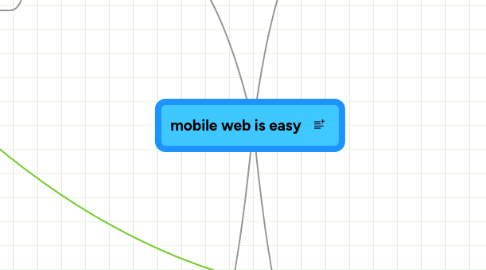
1. benefits
1.1. marketing
1.1.1. increase the brand
1.1.2. consumer conversations
1.2. monetisation
1.2.1. subscriptions
1.2.2. advertising
1.2.3. purchasing
1.3. service
1.3.1. consumer service
1.3.1.1. conference
1.3.1.2. tourism
1.3.1.3. education
1.3.2. government
1.3.3. non-profit
2. bemoko mobile web foundations
2.1. standards
2.1.1. HTML
2.1.1.1. HTML5
2.1.1.2. Semantic
2.1.2. CSS
2.1.3. Javascript
2.1.3.1. geolocation API
2.1.3.2. offline
2.1.3.3. AJAX
2.2. device awareness
2.2.1. device repository
2.2.1.1. device atlas
2.2.1.2. WURL
2.2.1.3. device detection for the masses
2.2.2. mobile switcher
2.3. analytics - measure success
2.3.1. admob
2.3.2. bango
2.4. think mobile
2.4.1. personal
2.4.2. omnipresent
2.4.3. more than the fixed web
2.5. Testing
2.5.1. real device testing
2.5.2. simulation
2.5.3. automation
2.6. further reading
2.6.1. mobiforge
2.6.2. little spring designs
3. mobile web ecosystem
3.1. web to mobile web
3.1.1. mobile web sites
3.1.2. widgets
3.1.3. HTML5
3.1.3.1. mobile web app
3.2. channel integration
3.2.1. SMS campaigns
3.2.2. local apps
3.2.3. voice
3.3. the players
3.3.1. apple
3.3.1.1. iphone
3.3.2. google
3.3.3. opera
3.3.4. operators
3.3.4.1. China Mobile
3.3.4.2. Vodafone
3.3.4.3. Telefónica
3.3.4.4. América Móvil
3.3.4.5. Telenor
3.3.4.6. China Unicom
3.3.4.7. TeliaSonera
3.3.4.8. T-Mobile
3.3.4.9. Orange
3.3.4.10. Bharti Airtel
3.3.4.11. MTN
3.3.5. device providers
3.3.5.1. Nokia
3.3.5.2. Apple
3.3.5.3. RIM
3.3.5.4. HTC
3.3.5.5. Samsung
3.3.5.6. Motoral
3.3.5.7. Sony Ericsson
3.3.5.8. Palm
3.3.5.9. NEC
3.4. toolkits
3.4.1. app stores
3.4.1.1. apple
3.4.1.2. JIL
3.4.1.3. ovi
3.4.2. platforms
3.4.2.1. iphone
3.4.2.2. symbian
3.4.2.3. android
3.4.2.4. palm webOS
3.4.3. browsers
3.4.3.1. webkit
3.4.3.2. opera
3.5. features
3.5.1. user interactions
3.5.1.1. screen
3.5.1.2. haptics
3.5.1.3. sound
3.5.1.4. keypad and buttons
3.5.1.5. touchscreen
3.5.2. functions
3.5.2.1. voice
3.5.2.2. calendar and tasks
3.5.2.3. contacts
3.5.2.4. camera
3.5.2.5. music
3.5.2.6. gaming
3.6. metrics
3.6.1. admob
3.6.2. statcounter
4. bemoko
4.1. UI Management
4.1.1. Easing the creative process and delivery
4.1.2. Controlling the look & feel across all devices
4.1.3. Satisfy the lowest common denominator
4.1.4. Support latest functions
4.1.5. Create mobile web application using standard HTML, CSS & Javascript
4.1.6. Reuse
4.2. Context interaction
4.2.1. Device
4.2.2. Location
4.2.3. Channel
4.2.3.1. SMS
4.2.3.2. Web
4.3. Content integration
4.3.1. Twitter
4.3.2. RSS
4.3.3. CMS
4.3.4. Database
4.3.4.1. SQL
4.4. Identity
4.4.1. Personalisation
4.4.2. Maintain conversation
4.4.3. Track and audit
4.4.4. improve customer support
4.4.5. Security
4.5. Tweaking
4.5.1. Deal with device non-compliance and pains
4.6. Site heirarchy
4.6.1. Reuse functionality
4.6.2. White label and re-brand
